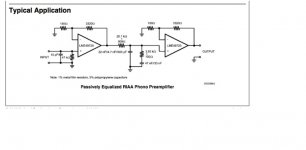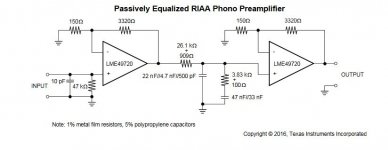I have built this CNC phono pre for MM stage. It uses LME49720 for gain. Im using new AT VM540(giant slayer!)but it needs more gain. It is based on the passively EQ'd phono stage TI app note. My question is how do I increase overall gain? If I just increase gain of one stage that would throw off EQ wouldn't it?
If you increase the gain, that will adjust the response curve and it may no longer be RIAA compliant.
You could use a line buffer after your RIAA, like a TL072, set to a gain of 10 and reduce the output by, say for example, 5 ensuring the output is five times as much but the noise level, if any, created by the TL072 is reduced by half, as we are halving the output and become unnoticeable.
A schematic of your preamp could have given a clue.
You could use a line buffer after your RIAA, like a TL072, set to a gain of 10 and reduce the output by, say for example, 5 ensuring the output is five times as much but the noise level, if any, created by the TL072 is reduced by half, as we are halving the output and become unnoticeable.
A schematic of your preamp could have given a clue.
The comment about the schematic is very valid, otherwise, it's like "Please help me but find all the info yourself" 😉
Anyway, Google is our friend - schematic is attached.
RIAA correction is 100% passive here, so two non-inverting amplification stages don't really influence the curve.
Voltage gain is set by 3320R and 150R resistors, giving us (3320/150)+1 = 23 times. Overall gain at the low frequencies is 23*23 = 529 times, which is 20*log(529) = 54.5db
You can adjust the gain changing the value of 150R resistors - see the first formula above (the lower the value -> the higher the gain).
I hope you need to increase the gain not too much - 2 times or so, right?
In this case, you can keep the gain stages equal.
Putting 100R instead os 150R in both gain stages will give you roughly 2 times (6db) gain increase.
Cheers,
Valery
Anyway, Google is our friend - schematic is attached.
RIAA correction is 100% passive here, so two non-inverting amplification stages don't really influence the curve.
Voltage gain is set by 3320R and 150R resistors, giving us (3320/150)+1 = 23 times. Overall gain at the low frequencies is 23*23 = 529 times, which is 20*log(529) = 54.5db
You can adjust the gain changing the value of 150R resistors - see the first formula above (the lower the value -> the higher the gain).
I hope you need to increase the gain not too much - 2 times or so, right?
In this case, you can keep the gain stages equal.
Putting 100R instead os 150R in both gain stages will give you roughly 2 times (6db) gain increase.
Cheers,
Valery
Attachments
The passive network reduces the first stage gain to 27.2 - 20dB = 7.2dB @1kHz, with the second gain stage @27.2dB you have total of 34.4dB. 40dB is what you should be aiming for. You can partition it equally between each stage by increasing the feedback resistor to 3.9k and reducing the gain setting resistor (150R) to 82 Ohms. The LME49720 shouldn't have problems with this.
Passive RIAA equalization and opamps often don't go well together as they don't have the over-load margin to deal with clicks and pops.
Passive RIAA equalization and opamps often don't go well together as they don't have the over-load margin to deal with clicks and pops.
Last edited:
Thanks everybody. Yes I wanted to attach schematic but always have trouble attaching images. So after reading this it seems like Jackinnj is making the most sense. If I was getting ~55db gain I wouldn't need anymore with MM cart. Taking filter losses into consideration though ~35db gain is more what I'm hearing.
So I was just going to adjust gain of last stage. Is there a reason why I would want to adjust gain of both instead?
So I was just going to adjust gain of last stage. Is there a reason why I would want to adjust gain of both instead?
The 10pF cap at the input is just for cartridge loading correct?
Yes, but the recommended loading is 100-200 pF including tonearm wiring.
Is there a reason why I would want to adjust gain of both instead?
You could make the first stage lower gain -- that way it won't overload as easily -- in Walt Jung's Op Amp Applications he uses 27dB in the first stage and 32dB in the second.
Rf1=2.37k Rg1=100R
Rf2=3.92k Rg2=100R
LME49720 input bias current is ~70nA so you will have ~75mV of DC on the output --
It's not the first stage to get overloaded , it's the second when the dust hit the stylus.I personally think that if the stylus can't get you enough voltage for this stage...you better go active way .Lm4562 is not the best op amp for this job.LT1115 is way better for both passive and active versions because of the higher power supply limits .Try also m5220 .It was widely used in cassette players and it has a max supply voltage of +-25v being very low noise and spec'd for riaa use.
Last edited:
Try also m5220 .It was widely used in cassette players and it has a max supply voltage of +-25v being very low noise and spec'd for riaa use.
Good thought -- he's gonna have to keep his fingers crossed that they are originals and not fake, however.
Input bias current M5220 is 700nA
OPA2604 is good to +/-24V. I haven't used it for phono-preamp so can't comment on the other aspects.
Ok so what I have done is up the gain symmetrically between the stages. Changed the 150 ohm to 75 because it is what I had on hand. Also upped the power supply batteries to +/- 12vdc. Haven't had a chance to extended listening but does have enough gain now. Thanks everybody!
Somebody else told me that lt1115 might not be good for the job.Indeed it's not good for an mm cart mainly because of it's low input impedance.The current noise is acceptable.Unfortunately with all phono preamp is that the minimum theoretical power supply that allows perfect reproduction is +-35v which makes for the fact that you need a compressor cause you're not going to drive your favorite amp with 70v signals. The only problem with vinyl reproduction is the dust.If you clean your vinyls there's no problem even with +_12v power supplies.If you're lazy like me...the only real soluton is a valve preamplifier and that amp needs also a section that is clipping softly when the stylus hits the dust particles.There's no other way to go with phono preamp than to have a compressor or a natural soft clipping circuit and that is why you can't go too wrong with valves.
Unfortunately with all phono preamp is that the minimum theoretical power supply that allows perfect reproduction is +-35v which makes for the fact that you need a compressor cause you're not going to drive your favorite amp with 70v signals.
Got a reference for that as not sure I believe it?
I won't risk another private message...I just read lots of guys telling that the dust makes the signal rise 100x the normal output...I also found some reference phono preamps that had +-35...40v supply so i assumed that these guys must be right about that.I've actually listened to some preamps supplied at +_15...+_18v that were good enough for my ears...but they were current feedback types...I just assumed again that current feedback types must be exempt from the rule 🙂
A healthy overload margin is good to have, but 25dB gives you enough headroom. And it is very dependent on the topology as to what rails are needed for that. Passive RIAA is very popular these days which will attenuate tics and pops considerably as they are transient events so have most of their energy at high frequencies. So only the first stage is critical. This is why you don't put all your gain into the first stage if you can help it.
Excess is common in high end audio so you will find overkill as overkill sells!
Excess is common in high end audio so you will find overkill as overkill sells!
I have build this CNC Phono Stage. Link here. My OpAmp is OPA2132P. Earlier It was run by 9V batteries. As some builders in another forum has suggested it sounds good with 12v supply. Now I will be running with power supply of Dual 12 Volts. Which is also finished. So before I buy 12v transformer for it. Should I be worried about dust pop and clicks ? which may result in overloading the circuit.
Last edited:
I don't understand your question. Increasing supply rails from 9V to 12V will reduce overloading.
Pardon me. My understanding of electronics is rudimentary. I doubt if I will understand elaborate technical explanation. But what I understand is if this circuit has passive equalisation it attenuates things (signals) and supplying higher voltage, the clicks and pops will have more room and will not load the circuit ?
Need to learn the basics. Going back in to the shell. 🙂
Need to learn the basics. Going back in to the shell. 🙂
More PSU headroom will give more overload headroom. However the RIAA passive eq already attentuates HF overload by 40dB so as previously said, its only the first stage you have to worry about. 27dB. Your gain is 22 in that stage if built to app note. 9/22 is .4V peak to clip so roughtly .3vRMS. A 5mV nominal cartridge would be having to give 40x its nominal output so you have a 32dB overload margin where it matters. IMO ample with the batteries.
- Status
- Not open for further replies.
- Home
- Source & Line
- Analogue Source
- CNC Phono Pre Gain ??

